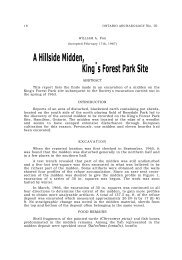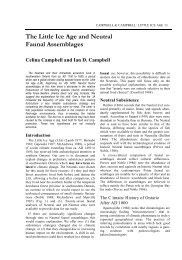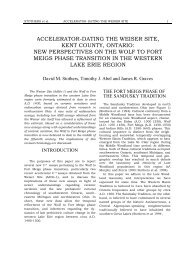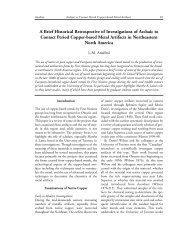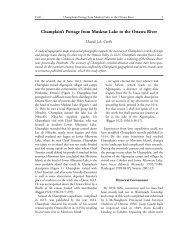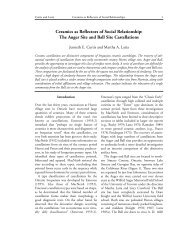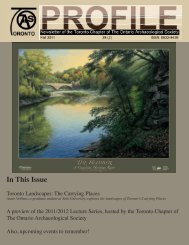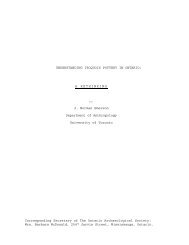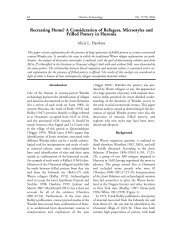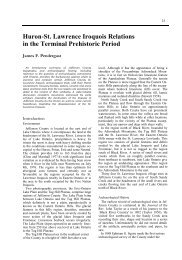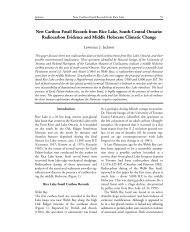oa 76 layout part 03 - Ontario Archaeological Society
oa 76 layout part 03 - Ontario Archaeological Society
oa 76 layout part 03 - Ontario Archaeological Society
- No tags were found...
Create successful ePaper yourself
Turn your PDF publications into a flip-book with our unique Google optimized e-Paper software.
4 <strong>Ontario</strong> Archaeology No. <strong>76</strong>, 20<strong>03</strong>Early Works: Preliminary Glimpses of the First Military Complexat Point Henry, Kingston, <strong>Ontario</strong>, 1812-1827Henry CaryIn the first months of the War of 1812, work <strong>part</strong>ies of Canadian militia and British regulars began clearingand fortifying the high ground of Point Henry, Kingston, <strong>Ontario</strong>. Over the next several years the temporaryworks were expanded and improved to become a large military complex and the chief depot forUpper Canada. However, in the late 1820s plans were drafted to replace the existing fort with a masonrycitadel; construction for the new fortification would be so extensive that by mid-century most traces of theoriginal structures were completely removed. Evidence of the site’s earliest occupation would not re-emergeuntil the mid 1990s, when archaeological testing uncovered foundations pre-dating the second Fort Henry.Since then, historical research and excavations by Parks Canada have revealed more about the first fort’sboundaries, architecture, and something of its builders and garrison. This essay presents some preliminaryglimpses of the first Point Henry complex and discusses areas with potential for future research.A Brief History of the Early WorksPoint Henry’s commanding view of Kingston andits naval appr<strong>oa</strong>ches from Lake <strong>Ontario</strong> and theSt. Lawrence and Cataraqui Rivers would beunappreciated until relatively late in the area’s militaryhistory. When the French establisheddefences in Kingston in 1673, they did so not onPoint Henry or similarly elevated ground, but ona low plain on the Cataraqui’s west shore. Theirfort, named for the Governor of New France,Compte de Frontenac, evolved into a substantialmasonry work, yet one strategically situated topromote trade and Christianity with the localnative population, protect habitant farms, andcover the maritime supply routes (Osborne andSwainson 1988:10). Fort Frontenac’s destructionby the British in 1758 ended Kingston’s militaryoccupation until 1783, when the fort was rebuiltfor Loyalist settlers flooding into Upper Canada atthe close of the American War of Independence.Before the settlers had arrived, Major John Rosssuggested to Upper Canada’s Lieutenant-Governor Sir John Graves Simcoe that PointHenry be considered as a defensible position, butSimcoe saw more strategic worth in York (nowToronto) and the Niagara Peninsula, and wasreluctant to commit resources to Kingston despitepressure to do so from his superior in Québec,Governor-General Lord Dorchester (Macleod1972:172; Osborne and Swainson 1988:47-48).British policy changed abruptly with theAmerican declaration of war on June 18, 1812.The next month, a <strong>part</strong>y of local militia under thecommand of officers from the RoyalNewfoundland Fencible Regiment began clearingthe trees and brush on Point Henry to erect ablockhouse and battery on the heights (Mecredy1985:3). From here maritime traffic on Lake<strong>Ontario</strong> and the St. Lawrence could be monitored,and the vulnerable east flank of the RoyalNavy shipyards, operating in Navy Bay since thelate 1790s, could be protected. The defences werecompleted just in time: on November 10, 1812, asmall group of American warships attempted araid on Kingston, but were successfully repelled,in <strong>part</strong> through the actions of the Point Henrybattery (Hitsman 1999:110). While brief, theaction reinforced the need to build stronger fortificationsshould the Americans launch a morecoordinated invasion. In response, militia and regulararmy details enclosed the Point Henry summitand began constructing permanent defences(Mecredy 1985:4). This work was accompaniedby construction of batteries at Murney andMississauga Points, fortifications at PointFrederick, and blockhouses and a palisade line thatencircled Kingston’s western flank.
Cary The First Military Complex at Point Henry 5By October 1813, Royal Engineer CaptainBenjamin Marlowe could report that despitelabour and material shortages, progress had beenmade at Point Henry (Mecredy 1985:9-10).Contemporary plans show a defensive trace thatincorporated many classic fortification elements:on the north front were two demi-bastions and aravelin that shielded the north gate, while on thewest and east fronts were two redans that allowedartillery to cover the curtain walls on the east andwest appr<strong>oa</strong>ches (Figure 1). A half-moon (alsocalled a demi-lune) battery on the south provided180-degree range of fire to the water-side. Fromnorth to south, the site was about 710 feet(216.5 m) long, and at its widest east-west, was500 feet (153 m). A 37.5-foot (11.4 m) wide and12.5-foot (3.8 m) deep ditch was cut around thenorthern demi-bastions by 1814, but subsequentelevation drawings, sketches and watercoloursindicate the ditch was never extended more thana few metres south of the northwest and northeastcorners. Renderings also show the west, east,and southern walls located slightly down-slopefrom the parade, producing walls that appearhigh on the exterior, yet were only about waisthigh on the interior; this arrangement providedFigure 1. The anatomy of FortHenry, from a May 1814 plan(LAC NMC 4677).
6 <strong>Ontario</strong> Archaeology No. <strong>76</strong>, 20<strong>03</strong>little cover for the buildings inside the fort,which stood proud on the horizon when viewedfrom both Kingston and Lake <strong>Ontario</strong>.The trace remained virtually unalteredthroughout the fort’s history while numerouschanges were made inside the work (Figure 2).By 1814, three long barracks probably of logconstruction were located on the eastern side,and on the west two small wood buildings and a50x50 foot (15.24x15.24 m) stone defensibletower had been constructed. Two wood structureswere placed within the demi-lune battery,and the 1812 blockhouse still stood in the north.The following year, the eastern barracks weregone and in their place stood another 50 footsquare stone defensible tower, followed in 1816by a 78x32 foot (23.8x9.75 m) stone powdermagazine with surrounding blast wall in thesoutheast corner. Between the towers, and orientedeast-west, were two 111x30 foot (33.8x9.1m) two-storey masonry soldiers’ barracks constructedbetween 1819 and 1820. On the sameaxis to the south a 233x40 foot (71 mx12.2 m)two-storey stone officers’ barracks was added in1820. By the late 1820s some of the earlier woodbuildings still survived, notably the guardhousenear the north gate and a stable in the west centre,and several stone privies had been built; oneFigure 2. The evolution of thefirst fort interior architecture(reconstruction by H. Cary).
Cary The First Military Complex at Point Henry 7east of the soldiers’ barracks and six in the areasouth of the officers’ quarters. It appears a screenwas erected around these structures, probably foradded privacy and to deflect the odours carriedon the prevailing southwesterlies.Major construction was also taking place onPoint Henry’s shore throughout the years 1812-41.The land was divided into B<strong>oa</strong>rd of Ordnance andRoyal Engineer De<strong>part</strong>ment yards on the NavyBay side, and a garrison hospital complex onHamilton Cove, now called Deadman Bay (Garcia2006:2). Lieutenant-Colonel Elias WalkerDurnford (1824), then Commanding RoyalEngineer for Canada, produced detailed records,plans and elevations of the magazines, warehouses,shops and offices on the military reserve in 1824,and Royal Engineer Major Richard Bonnycastleand Ordnance Storekeeper Smith (Bonnycastleand Smith 1831) conducted a similarly extensivesurvey in 1831. Ten years later another inventorywas taken by Royal Engineer Lieutenant A.H.Freeling and Ordnance Storekeeper JamesWindsor (Freeling and Windsor 1841). However,by this time much of the first fort had already beendestroyed. Since June 18, 1832, construction hadbegun on a stone casemated redoubt that over thenext three decades would completely replace theexisting complex and become one of Canada’slargest and most expensive defences. The firstbuildings to go were those inside the fort’s northernhalf, and the addition of two Commissariatranges in 1841 called for the last structures insidethe first fort to be removed. Four years later, theNavy Bay buildings were demolished or re-locatedto the north, and all but the stone guardhouseof the eastern hospital complex were torn downduring the Second World War to prevent, in <strong>part</strong>,the PoWs held inside the Redoubt from using thebuildings as cover during an escape attempt.The First Fort RediscoveredEvidence of the earliest Fort Henry was firstunearthed in 1994 when Heritage QuestIncorporated was carrying out excavations priorto the installation of a sewer line (Bazely1996:50-52). On the glacis close to the EastCommissariat Range, two foundation walls wereunearthed, one 60 cm wide and another 70 cmwide, both clearly predating the 1842Commissariat construction. A limited scheduleprevented examining these walls further, but theyprovided definitive proof that some elements ofthe first fort still existed (Bazely 1996:50-52).Another investigation of the first fort complextook place in 2000, when the Catarqui<strong>Archaeological</strong> Research Foundation conductedsmall-scale excavations on the garrison hospitaland associated structures (Bazely 2004:38-40).Parks Canada <strong>Archaeological</strong> Services did notbegin work on the first fort until 2002, whenseveral early occupation deposits were uncoveredat various locations in the Advanced Battery(Figure 3). On the east side of the ramp entrancewhat appeared to be an early MacAdam surfacewas exposed and near it were found pre-1832 sodand burn layers (Cary et al. 2005:6, 10). An earlydebris level was also excavated near the centre ofthe Advanced Battery parade, although littleinformation about the early period could begleaned from these initial findings.More substantial remains were found inNovember 2002, when earth behind the entranceramp walls was being removed. Backhoe and shovelwork near the ramp walls’ curbs uncovered largeamounts of stone and brick debris, prompting ahalt to the mechanical excavation and more carefulexcavation by trowel. Behind each wall, 2 mwide stone foundations were exposed, and theseappeared to have been bisected by the 1832 rampwalls’ construction. It was concluded the foundationsmust have been there before the ramp wasbuilt, and were possibly contemporaneous with aMacAdam surface unearthed north of the foundations(Cary et al. 2005:10).The foundations’ dimensions suggested theyhad supported a large building, but which one?The initial problem faced was that the first fortboundaries were unknown. An 1832 elevationdrawing (LAC NMC 20788) showed how thenew Fort Henry would replace the existing buildings,but as this was a proposal sketch little confidencecould be placed in whether this was eventuallybuilt. Susan Bazely (personal communication2002) had determined the relationship
8 <strong>Ontario</strong> Archaeology No. <strong>76</strong>, 20<strong>03</strong>Figure 3. Excavations at Fort Henry, 1994-2005, with the first fort structures plotted over t he modern landscape.between the two fortifications using as a commonreference point the present well and one shownon an 1814 plan; however, the well appears infrequentlyon early plans and was too ephemeral t<strong>oa</strong>ccurately plot the first fort buildings.A breakthrough came with the discovery of aDecember 1833 plan (Wright 1833:188) showinghow much of the Redoubt had been built tothat date. Importantly, it displayed the relationshipbetween the barracks and towers of the firstfort with the walls of the Redoubt. Now armedwith the necessary link between the first and secondfortifications, the early complex could beplotted on the modern landscape. Using digitalmapping software the progress report plan wasscaled over a recent aerial photograph using thefirst fort towers and <strong>part</strong>ially completed Redoubtas benchmarks. The resulting map was bothinstructive and disappointing. Half the formerwork was where the Redoubt now stands, an areaknown from other investigations to have beenexcavated up to two metres into bedrock to createthe defensive ditch of the new fortification(Cary et al. 2005:11). On the positive side, themap indicated the southern portion of the 1812fort, including the officers’ barracks and powdermagazine, to lie beneath the Advanced Battery.Instead of being mined, this portion of the sitehad been filled with stone debris originatingfrom the Redoubt ditch. Closest to the ramp wasthe officers’ barracks which, accounting for theimprecision of the overlay, was tentativelyassigned to the foundations bisected by theramp.
Cary The First Military Complex at Point Henry 9Excavations in 20<strong>03</strong> and 2004 revealed a greatdeal more about the first Fort Henry. Within an“L”-shaped unit on the west-central section of theAdvanced Battery parade an early deposit wasfound that included a range of objects such asceramic soup tureen fragments, pieces of a “basketware”ceramic bowl, stemmed wine glasses,high quantities of domesticate animal bones, andwine bottle, decanter and tumbler fragments(Cary et al. 2005:11). Most of these artifacts wereof a quality more typical of an officers’ table thanthat of the average enlisted man, but had beenunearthed nearly 33 m south of the ramp way,where the officers’ barracks was surmised to stand.The dilemma was fortuitously solved in thefall of 20<strong>03</strong>. On the west glacis path two stones<strong>part</strong>ially covered in sod were noticed on the surface,and these seemed to follow an east-westline. When the soil was peeled from the stones,another aligned block appeared, and one more ascuts were made to the west. This turned out to bea substantial masonry wall, over 1.20 m thickand 1.80 m high, located very close to where theoverlay had projected the south wall of the officers’barracks. Additionally, it was only 5 mnorth from where the higher quality artifactswere uncovered on the Advanced Battery parade.The conclusion was clear; it was this foundation,not the one in the ramp, which had once supportedthe 1820-1841 officers’ barracks (Cary etal. 2005:12).Early the following year, the stone foundationexcavated by Bazely in 1994 was re-discoveredoutside the East Commissariat Range. It wastrenched south for three metres before the decisionwas made to stop digging and wait untiltime permitted careful investigation of the feature.This came in July when the southwest cornerof the officers’ barracks was uncovered only4.75 m from the previous excavations. With thislandmark, the overlay was used to determine thewalls outside the East Range to be <strong>part</strong> of the1819 powder magazine (Cary et al. 2005:25). Tolearn more about the magazine, its wall was followeda further five metres southward until thesouth gable end wall was reached.The opportunity to explore the Ordnance andRoyal Engineer yards on the west glacis arrived inJune and July 2005. Here locating historic structuresusing the overlay proved discouraginglyinconclusive, with greater success achieved whenexcavations were carried out over surface featuresdiscovered while field walking. Portions of thenorth, south, and west faces of an 1819 guardhousewere exposed in four units; the northwestand southwest corners of the 1820 Clerk of theCheque’s House were revealed in two units; andeight units were dug on the exterior and interiorof the 1827 Ordnance Store No. 2. Two moreunits unearthed portions of a r<strong>oa</strong>d and subsurfacedrain. While the overlay did not help locatethese structures, once excavation was complete itaided in identifying them.Discoveries of Fort Henry’s early nineteenthcenturyoccupation have thus far been dispersedand limited. However, enough data has been collectedto <strong>part</strong>ially reconstruct the architecturaldevelopment of the first complex and learn moreabout what life was like for those who built andgarrisoned it.The Cultural LandscapeThe landscape of Point Henry has undergonesome significant changes in the past 190 years.Clearing the site of vegetation took the militianearly a year (Mecredy 1985:7), although thisappears a relatively small task compared to thenearly twenty years, beginning in 1841, it tookthe Royal Engineers to sculpt the glacis of thesecond fort with rubble fill. Contemporarysketches and paintings of the first and secondfort provide some indication of this transformation,with finer details emerging when the topographyof the earliest surfaces unearthed at FortHenry were mapped. By plotting the historic elevationsin relation to height above sea level, theoriginal ground inside the fort was found to beonly slightly more undulating than present, yetdropped away steeply on the west flank. Forexample, beneath the southwest corner of theofficers’ barracks, the natural strata falls just overone metre within a 4.5 m run, and must havedescended even more before reaching the 1812southwest curtain wall. After 1841, loose stone
10 <strong>Ontario</strong> Archaeology No. <strong>76</strong>, 20<strong>03</strong>fill was used to moderate the steepness of thisgrade. Northwest of the fort, in the originalOrdnance Yard, few modifications took placeexcept at the eastern boundary, where increasinglythick layers of fill were deposited after the secondfort construction.In adapting to the natural topography insteadof manipulating it, the first Royal Engineers onPoint Henry were following practices similar tothose enacted elsewhere in Canada during thelate eighteenth and early nineteenth centuries.For example, at Fort George, Niagara-on-the-Lake, the Engineers simply enclosed the highground rather than level the parade inside, leavingthe historic parade at a higher elevation thanits bastions and curtain walls (Fox 1996). Suchwillingness to adapt to local terrain was replacedlater in the nineteenth century by the desire andmeans to create a new landscape. This is clearlyseen at the second Fort Henry and HalifaxCitadel, where building the fortification involvedsubstantially changing the country by diggingand filling.Less dramatic additions to the early landscapewere parade surfaces, r<strong>oa</strong>ds, and below-gradedrains. Inside the first fort a MacAdam pavementof 8-12 cm cobbles impressed into a 2-3 cmthick clay substrate was uncovered; named for itsinventor John Loudon MacAdam, surfaces likethis are common to British military sites, withexamples similar to Fort Henry found at FortMississauga, Niagara-on-the-Lake (Last 1997).The pavement may not have covered the entirefort interior, possibly only between the soldiers’and officers’ barracks, as it was not found southof the latter structure. A similar pavement wasused to create a r<strong>oa</strong>d that ran through theOrdnance Yard. Here a variety of stone types andsizes were present but all were laid over a claybase. Stone debris found where the r<strong>oa</strong>d abuttedthe west wall of the 1819 guardhouse may haveserved as a French drain to keep water from poolingon the r<strong>oa</strong>d and around the guardhousefoundations. South of the guardhouse a 25 cmwide stone channel capped by limestone slabs upto 75 cm long was unearthed, which directedwater towards Navy Bay. Despite being omittedfrom historic plans of the area, it is likely thatmany such drains were installed in the OrdnanceYard to channel runoff from the steep slopes ofthe Point.Inside the First FortThe 1820 Officers’ BarracksLimited excavations of the officers’ barracks—just 2.8% of the total structure—revealed a surprisingamount about the building’s constructionand its inhabitants. The foundations provide anintroduction to the structure’s scale: robustlybuilt using two parallel wythes of squared limestonerubble, averaging 40x15 cm in size and infilledwith rubble and mortar, the walls are 1.15m to 1.20 m wide on the south façade, and 1.10m wide on the west gable end (Figure 4).Between one-third and halfway up the excavatedinterior of the south façade the masonry narrowsto 1 m in width, creating an 8-20 cm wide ledge.This step construction centres the vertical andlateral thrust from the upper wall sections androof, and probably also supported interior floorjoists. The façade wall foundation was laid directlyon the sloping surface of bedrock and rises inelevation towards the centre of the structure andthe summit of Point Henry. Conversely, thegable wall foundation was laid against a verticalcut in the bedrock, and built tall to account forthe rising façade wall. Despite this added height,neither the gable or façade foundation wouldhave been visible during the occupation period.The walls’ exterior was covered by successive layersof rubble, mortar, and clay, some of whichrelate to the barrack’s construction and othersthat were used to landscape around the foundations.These fills were laid periodically over thestructure’s lifetime and one of the top-most layerscontained granite that probably came fromthe Redoubt defensive ditch in 1832.Fill was not similarly deposited inside the barracks.If the interior ledge on the façade wall didsupport floor joists, there was a crawlspace at thegable end that varied from 0.55 cm to 1.20 mhigh, but one that diminished towards the centreof the building, 30 m away, because of the risingbedrock elevation. Bonnycastle and Smith’s
Cary The First Military Complex at Point Henry 11Figure 4. Excavations on the southwest corner of the 1820 Officers’ Barracks, facing south. (Photo 131H653E by H. Cary).(1831:27) report states that the officers’ barrackshad a cellar, but does not mention where; itseems likely the cellar was situated on the westernside as the space had been built, and highnumbers of artifacts had been dumped there (seebelow).The relatively small grey stones of the foundationmay not be representative of the entireupper wall masonry. Bonnycastle and Smith’s(1831:27) report describes the officers’ barracksas having “a dressed front and back and ends ofrough coursed work,” which suggests an ashlarfinish for the façades and squared rubble for thegable end walls. All of the foundation stoneworkuncovered is coursed squared rubble , indicatingthat the original façade wall must have beencompletely dismantled. The above-grade façademay have also been of different stone than that ofthe foundations. A house at 247-249 BrockStreet, Kingston, is reputed to have been built in1843 using stones salvaged from the “old FortHenry” (Committee of Architectural Review1973:114-116), but it has an unusual yellowishtint at odds with the grey colour of the officers’barracks foundation. Stone from the barracks isknown to have been made available to the publicas an advertisement placed in the KingstonGazette (1841) on June 14, 1841 announcedthat all materials except the brick work would besold at auction and yellow-coloured stone wasalso used for other military structures inKingston, such as the “Stone Frigate,” built atPoint Frederick in 1820 (Angus 1999:110).However, no such yellow stone, except for onefinely cut block, was found within the barrack’sdebris that conforms to the Kingston house orthe Stone Frigate.There is more certainty about other elementsof the façade. For the windows, thin (1-2 mm)fragments of green pane glass were found, theirhue caused by an inability to remove sodium silicateduring the manufacturing process (Hodges19<strong>76</strong>:55). These were probably made as “crownglass” in England, which involves taking a gatherof molten glass on an iron rod and spinning it tocreate a large circular panel. The imprecision ofthe spinning method causes imperfections in theglass such as small bubbles of trapped air, and
12 <strong>Ontario</strong> Archaeology No. <strong>76</strong>, 20<strong>03</strong>these were evident on the pieces found aroundthe officers’ barracks. However, the glass uncoveredhere was probably of higher quality thanwould have been used on the men’s barracks. Ofthe five grades of glass produced—firsts, seconds,thirds, fourths and CC—it was the seconds thatwere usually reserved for an officers’ barracks(Vincent 1993:183). Despite its relatively highgrade, the glass used for the barracks may havebeen considerably cheaper than that available inBritain because glass for the export market wastax exempt (Vincent 1993:171). It can be postulatedthat the panes were once 8 1 /2x7 1 /2 inches(21.6x19 cm), one of the most popular sizes usedduring this period (Vincent 1993:202), and if thecomparable soldiers’ barracks at Fort Lennox areused as an example, these panes were set in “tw<strong>oa</strong>cross, six down” casement windows. Some of theglass may have also originated from the fan transomlights believed to have filled the entrance arches,or the sidelights of each north façade doorway.From Durnford’s report (1824:8) it is knownthat the officers’ barracks roof was covered in tin,but the archaeological findings helped flesh outthis description. Within one of the debris layerswere fragments of two 14x10 inch (35.6x25.4cm) tin sheets folded into four six inch (15.2 cm)wide sections. Overall the two tin sheets measured20.8 inches (53 cm) long and each pleatedsection was nailed with six 1 1 /2 inch (3.8 cm)wrought iron nails. The two sheets match the10x14 inch dimensions of tin roofing plate usedextensively in Canada during the early nineteenthcentury (Vincent 1993:110). A three inch(7.6 cm) wide band of dull metal on each plateshows either where the tin was exposed to theweather, or was originally beneath overlappingtin plates. The former arrangement of only 3inches (7.6 cm) exposed to the weather is a techniqueseen in the Caribbean where high windsare expected (Joseph Last, personal communication2005), while the latter leaves 7 inches (17.8cm) exposed, more typical of Canadian roofs(Vincent 1993:111). Chemical analysis of themetal concluded it was left unpainted (Unglikand Moyle 2004).Numerous complete red bricks, most averaging20x10x6 cm, and high quantities of brickfragments were found in the demolition debrisinside the foundations. These probably originatedfrom the structure’s fireplaces and internalchimneys but no remnant of fireplaces werefound on the gable end, even though two areshown on Durnford’s 1824 plan (Figure 5).From the 1841 newspaper advertisement it canbe deduced that the Royal Engineers had anexpressed purpose for the brick as it was specificallynot included in the salvage auction; perhapsthe hundreds of bricks used in the officers’ barrackschimneys were retained to construct thearched casemates of the second fort CommissariatRanges, and only the damaged and unsuitablepieces were left behind in the demolition. Theopen fireplaces shown on Durnford’s plan mayhave been replaced by more efficient stoves, theevidence for which is a circular-cut, yellow-tintedstone (mentioned above) that may have onceconnected a stovepipe to the existing brick chimney.Other building materials discarded inside thebarracks were wrought and cut iron nails andspikes. Fragments of up to 526 nails and spikeswere collected during the excavations, 194 ofwhich were complete. Sixty-four percent (n=125)are under 4 cm long, with the remaining numberbeing up to 12.5 cm long. The high percentage ofsmaller nails probably came from the lath, roofing,or interior trim work, and intentionally discardedin favour of larger nails salvaged from theframing and floor construction.By far the most ubiquitous architectural materialfound within the foundations was wall plaster.The plaster averaged 2-3 cm thick and wouldhave been applied directly to the stone and brickwalls, and over lath for the wood interior <strong>part</strong>itionwall and ceiling construction (Vincent1993:82). Wash or paint layers on the plasterindicated it had been periodically freshened inup to four colours ranging from zinc white toyellow ochre and burnt sienna (Ridley 2005).The 1877 Handbook for Military Artificersinstructed barrack walls to be painted “with twoc<strong>oa</strong>ts once in seven years internally” (quoted inRidley 2005:3) but repainting could have alsobeen carried out when a new officer moved intoquarters. A c<strong>oa</strong>t was probably applied after
Cary The First Military Complex at Point Henry 13Figure 5. Durnford’s plan and section of the Officers’ Barracks, 1824 (LAC NMC 4650).Durnford (1824:8) observed that the officers’barracks required “painting and whitewashing,”and other layers may date to when Fort Henrywas “sanitized” during Kingston’s 1832 and 1834cholera epidemics (Spurr 1975:28).When it was completed in 1820, the officers’barracks may well have been the largest structurein Kingston (Figure 5) (Robert Garcia, personalcommunication 2005). It was 5,320 square feet(494.4 square metres) larger than the combinedsoldiers’ barracks just to its north, yet housed just19 or 20 officers, giving each a personal spacebetween 1,458 and 2,916 cubic feet (41.3x82.5cubic metres); conservatively about seven timesthe amount for the regular troops (Cary et al.2005:66). Much of this space may have been leftvacant. Senior and married officers in theKingston garrison often kept homes in town(Spurr 19<strong>76</strong>:107), leaving only the junior officersto stay at the fort and supervise its daily operation.Even so, the officers’ barracks must havebeen at full capacity occasionally to merit constructionof six privies to the south.The scale, masonry, and visibility of the officers’barracks above the fort’s curtain walls madeit a prominent feature of the Kingston skylineand a tangible symbol of British military protection,sovereignty and control. Its architecturemirrored the tastes and fashion of the militarycommand, although its style was also popular incivilian circles. During the early seventeenth century,architect Inigo Jones introduced Greek andRoman motifs to Britain and with it came anemphasis on order and symmetry (Summerson1970:117). This architectural style is known variouslyas neo-classical, Palladian, and laterGeorgian, of which the officers’ barracks possessedmany typical elements; the placement of
14 <strong>Ontario</strong> Archaeology No. <strong>76</strong>, 20<strong>03</strong>windows and doors is geometrically balanced andthe massing of the central pediment, completewith ox-eye, was influenced by Greek temples.The archway in the building’s centre and archeddoorways are of Roman origin. Dwellings big andsmall, and <strong>part</strong>icularly institutional buildings,were built in the neo-classical style throughout theseventeenth, eighteenth, and early nineteenth centuriesuntil gradually falling out of fashion in thelate Regency period (Kindler 1974:23). So popularwas neo-classical architecture that inhabitantsof houses built in earlier styles sometimes transformedasymmetrical façades to ape the Georgianideal (Deetz 1996:158-161).Unlike other buildings of the first fort complex,the lineage of the officers’ barracks is relativelysimple to trace. When touring Canada’sdefences in 1819 Governor-General CharlesLennox, the fourth Duke of Richmond, was s<strong>oa</strong>ppalled by the state of the troops’ wooden barracksat Fort Henry that he immediately orderednew permanent masonry accommodations forboth the officers and men. This was done withsuch rapidity that Durnford (1827:211) wouldlater complain to the Inspector General ofFortifications, Gother Mann, that “the buildings[the mens’ and officers’ barracks] were ordered bythe Commander of Forces (His Grace, the lateDuke of Richmond) without previously consultingme.” From this exchange it appears thatDurnford had little to do with the officers’ barracksdesign but it may have originated withanother Royal Engineer. Richmond’s officers’barracks is very similar to those proposed in1816 by Royal Engineer Lieutenant ColonelGustavus Nicolls for the deferentially namedFort Lennox, Québec (Charbonneau 1994:189),and it is possible Richmond simply took themoff the shelf and modified them for use at FortHenry. Determining where Nicolls’ design camefrom is more difficult because it was not till thelate 1790s that the Royal Engineers received cursoryformal training in architecture (Clerk1984:16), something Nicolls may not havereceived as he was commissioned in the RoyalEngineers in 1783 (Charbonneau et al.1982:172). Inspiration for the barracks may havecome from the numerous style books publishedduring the eighteenth and nineteenth centuries(McMordie 1975), or by looking at the myriadof similarly-styled barracks, institutions, andcountry homes of Britain (Douet 1998).However, unlike aristocratic houses, the classicalembellishments selected for military buildingshad to be mitigated by the costs of importedmaterials such as tin, brick, and window glass, allpurchased on the Ordnance account.From the exterior alone, there appears to beinherent class distinctions between the officers’barracks and the two soldiers’ barracks built to itsnorth. The soldiers’ barracks are utilitarian structuresof simple Georgian balance, a seeminglyperfect structure to satisfy the working classtastes of the regular soldiery, while the officers’barracks mirrors the classical education of itsmiddle-class occupants. Other sites confirm howarchitecture conveys hierarchy; at Fort Georgethe officers’ quarters is an ornate and delicatebuilding compared to the three robust defensibleblockhouses that housed the men. This theorybreaks down, however, when Fort Lennox isincluded as an example. Here it is the soldiers’barracks that closely matches the officers’ barracksat Fort Henry, while the officers’ barracks atthe former is a quite different structure altogether.The officers’ barracks façade at Fort Henry,then, cannot represent the officer class if thesame design was being used as a soldier’s barrackselsewhere. But if housing for the officers and soldierydid not require architectural difference,why not build two identical structures and useone for the officers and one for the men? Itappears that the Duke of Richmond, despiteusing a design for one group at Fort Henry thathad been used for another group at Fort Lennox,maintained a contrast between the soldiers’ andofficers’ barracks, thereby reinforcing class andrank distinction in a more local sense—withinFort Henry.Certainly life inside the officers’ barracks wasvery different than across the parade. Theincreased personal space is one example, whileothers can be gleaned from analysis of the materialculture found inside and near the foundations.One of the most predominant artifactgroups unearthed were fragments of ceramic
Cary The First Military Complex at Point Henry 15tableware, of which three different types are present:creamware, pearlware, and refined whiteearthenware. Overall, we found fragments fromup to 41 ceramic vessels—18 creamware, 11pearlware, and 7 refined white earthenware—informs ranging from bowls, plates, twifflers (smallplates), saucers, a spice b<strong>oa</strong>t, and a pitcher. Allare decorated in a wide array of transfer printsand edging. Other tableware vessels found weremade of porcelain, bone china, and finestoneware, as well as a fragment of a basalt or“Egyptian Black” teapot with flower decorationin relief. The collection also included wine glasses,tumblers, decanters, and wine bottles (Cary etal. 2005:74-85).The outward appearance of wealth this rangeof material suggests is not entirely opulent. Theglass and ceramic tableware was well made, butcould be bought at modest prices, and would notbe out of place in a middle-class home inKingston during the early nineteenth century(Phil Dunning, personal communication 2004).Officers, while generally of privileged or middleclassbirth, were usually second sons or furtherdown the inheritance list and what funds theyhad were soon whittled away by the institutionaland social obligations of military life (Holmes2001:415). If a young officer did not have topurchase his commission, a practice affectingabout half of new positions during this period(Glover 1980:234), he would be required tospend a small fortune on his deportment: a uniform(a fragment of gilt lace from an officers’tunic was uncovered), riding tack, a horse,weaponry, and other trifles such as his personaltoilet (also found was most of a plain creamwarewash basin jug called an ewer, a bone shavingbrush handle, and a tin glazed medicine jar).This was followed by the mandatory officers’ messmembership fees. By then, many officers weremired in debt, often prompting the mess to economizeon its tableware purchases to reduce theburden on its poorer members (Senior 1981:148).Examples of this are visible in the officers’ barrackscollection. A refined white earthenwarepitcher fragment, decorated with a “Brosely,” or“Temple” transfer print, and two creamwareplate fragments show deficiencies that mighthave placed them on the “seconds” market (Caryet al. 2005:21). The glaze on the plate fragmentswas imperfectly fired, and the transfer print onthe pitcher does not line up, leaving an irregularpattern. But some objects were of greater value.Two wine glass sherds were unearthed that hadbeen etched with the Roman numerals “L” and a<strong>part</strong>ial “X”, encircled by a double lined cartouche,an oval or oblong graphic that encircles adesign. One of the fragments has a <strong>part</strong>ial rim,which allowed for an estimate of the shape andsize of the wine glass to be determined, andalthough the two shards did not mend together,they are likely from the same trumpet bowl-typevessel popular during the first <strong>part</strong> of the nineteenthcentury (Jones and Smith 1985:38-39).The etching was clearly a regimental mark, butone difficult to identify specifically since ten ofthe twenty-one line regiments who served at FortHenry between 1812 and 1841 had “LX” as <strong>part</strong>of their mark (Spurr 1972:30-32). Several regimentscould be eliminated from the identificationbecause their marks were either too short ortoo long to fit into the cartouche, and this narrowedthe field to the 65 th (LXV) and 70 th (LXX)Regiments of Foot. Using regimental marksfound on previously excavated items such as acreamware soup plate from Fort Frontenac, itwas eventually deduced that the cartouche was“LXX,” or “70” (Cary et al. 2005:23). There isnot enough of the mark to confirm beyonddoubt that this wine glass once belonged to the70 th Foot mess, but the regiment did garrisonFort Henry while the officers’ barracks wasstanding between 1819 and 1821 (Spurr1972:30-31).Other findings indicate that the officers stationedat Fort Henry were not entirely impoverished.The tumblers, wine glasses, and wine bottlesare evidence of liquor consumption—anactivity condoned for officers yet prohibited forsoldiers in barracks—and the quantity and rangeof animal remains recovered shows a varied dietof domesticate mammal and bird, wildfowl, fish,and shellfish meat. Officers were allowed to huntand fish to supplement the mess table, and manyof the bird and fish remains may well have beenthe officers’ own quarry (Graves 1979:66-67).
16 <strong>Ontario</strong> Archaeology No. <strong>76</strong>, 20<strong>03</strong>The contents of the ribbed sauce, “London” mustard,and “Crosse and Blackwell” food bottlesunearthed would have contributed seasoning tothe fare.The latter artifacts such as these and the butcherymarks on the animal bones also provide a linkto those in the officers’ barracks who were not officers.Civilian cooks were sometimes hired to preparethe mess dinner, often extravagant multicoursedaffairs attended by waiters drafted fromthe garrison (Lambly 1984:49), and other remnantsof their presence might be fragments of acreamware jar, likely for food storage, and two vesselsof glazed course red earthenware and glazedcourse red stoneware. These may additionallypoint to the officers’ personal servants, usually veteranprivates in the regiment, who cooked the officer’sother meals and also saw to his deportment,such as cleaning kit (Graves 1979:70-71). The latteractivity may be represented by the sixDerbyshire blacking bottle and blacking jar fragmentsfound during the barracks excavations.The officers’ barracks provided more thanaccommodation for the junior officers. In 1838,the building was used as a courtroom to try Nilsvon Schoultz and the “Patriot Hunters” for theirrole in the 1837 Upper Canada Rebellion.Representing von Schoultz and advising “PatriotHunter” Daniel George in the court was a 23-yearold Kingston attorney named John AlexanderMacdonald (Graves 2001:173-174). His clientswent to the gallows, but thirty years later “JohnA.” would become Canada’s first prime minister.The 1819 Powder MagazineTypical of freestanding powder magazines builtduring this period, the foundation construction is<strong>part</strong>icularly massive, with a seven foot (2.1 m)thick foundation laid directly on the limestonebedrock. Being wider than the wall above it, thefoundation formed a pedestal for the one-storeystructure, instead of the buttress design favouredfor earlier magazines, which was found to contributeto internal dampness (Lewis et al.1848:317-318). E.W. Durnford must have beenpleased with this design, as he later suggested itreplace the failing buttressed magazine at FortYork (Benn 1993:82).Durnford’s 1824 plan (LAC NMC 4663)indicates that the walls were tied to an internalcasemate arch, and the near complete absence ofbrick debris suggests this vault was constructedin stone. A simple pitched roof covered the arch,which was framed in wood but sheathed in tin asa fire precaution (Durnford 1824:3). We can beless certain about where the entrance was located.Durnford’s plan shows it on the gable wallbut makes no mention of whether this was thenorth or south end. Usually a magazine doorwayis situated opposite to the primary threat; at FortGeorge, for example, the door is on the landwardside, opposite the American side of the NiagaraRiver. Determining the direction of Fort Henry’sprimary threat is less clear. The site was orientedto expect a northern attack, but placing the dooron the south would leave it exposed to navalbombardment from this flank. None of the historicplans or sketches are helpful in this regard,and it can only be assumed that the door was onthe south in keeping with the historical assumptionthat an attack would come from the north.The building plan shows as many as three interiorfoundations supported the flooring, andexcavations revealed one of these to be a 60-70cm wide coursed, squared rubble wall laid directlyon bedrock. Surprisingly, no copper nails—predominant in magazine construction for providingspark-free fastening for the floor and otherwood construction—were recovered beneath thefloor level, nor were there any charc<strong>oa</strong>l layerscommonly used as a desiccant. Instead, the spacebetween the interior supports had been filled bylarge angular limestone slabs, upwards of38x30x10 cm. It is unknown whether this was anintentional sub-floor fill, or debris depositedwhen the building was torn down, although theformer may have been laid to allow free drainagebeneath the magazine floor (Duffy 1975:77).Despite its solid construction, by the 1830s themagazine was of little value to the second fortdesign. Just eight years after it was constructed itwas listed in only “tolerable repair” and its masonryrequired pointing (Durnford 1824:3). In1841, it was dismantled down to only one-to-tworemaining courses. Twentieth-century utility lineinstallations destroyed sections of the northern
Cary The First Military Complex at Point Henry 17interior, and it is possible the east side of themagazine was removed by the 1996 sewage line,which runs along the East Commissariat Range.Only further excavation will tell how much ofthe building still survives.Other Structures Within the Fort WallsWithin the L-shaped unit inside the AdvancedBattery was discovered a 1x1 m section of flagstoneslaid around a stone-lined hole, 20 cm indiameter and 55 cm deep. Because so little wasexposed it is impossible to determine the feature’soriginal function, although one possibility is thatit was a corner post and flagstone floor for a temporarystructure. Cobble or flagstone flooringwas common in English barn construction(Stephen Mills, personal communication 2004),and post-in-ground or corner post constructionwas occasionally used for temporary structuressuch as lime sheds (Carter-Edwards 1985:46;McConnell 1977:46). Determining the flagstoneand post hole to be remnants of a building istherefore not unreasonable, but first it will benecessary to define the feature’s boundaries.As for the foundations in the ramp area—thewalls which initiated our research on the firstfort—neither the refined overlays nor surroundingartifacts have provided an indication of theiroriginal function. Once again, more excavation isrequired to fully understand this feature.The West GlacisThe 1819 GuardhouseOn the plain immediately north of the WestBranch Ditch several stones around a low squaremound (Figure 6) were noticed on the surface.Three units were dug on the mound’s perimeterand revealed two corners of a 50-70 cm widecoursed limestone rubble foundation. Fromthese corners the structure’s dimensions weredetermined to be 23.5x21.6 feet (7.18x6.5 m),conforming very closely to the 23x21 feet listedfor the Ordnance Yard’s one-storey stone guardhousebuilt in 1819 (Garcia 2006:89). The wallsstill stood up to 95 cm high and had been laidwith copious amounts of mortar within a narrowtrench cut 40-50 cm through natural soils. Onthe interior side of the east wall, notches spaced65 cm a<strong>part</strong> still supported 8-12 cm squaredwood joists that would have braced the floorb<strong>oa</strong>rds. Plaster found within the foundationsindicated the walls had been washed in a lightbrown colour.According to the records left by Durnford(1824:8), the guardhouse walls were built instone and the interior was divided into a frontroom with door to the exterior, a cell for prisoners,and bunk space around the fireplace on thegable wall. Windows lit only one side. AlthoughDurnford’s (LAC NMC 4645) plan gives no ideawhat direction the building faced, more generalhistoric plans show a porch on the north side ofthe structure. This can only have been associatedwith the doorway, placing the prisoners’ cell onthe northwest, the windows facing the r<strong>oa</strong>d tothe east, and the fireplace on the south gablewall. To search for the latter feature another uniton the guardhouse wall was opened but, like theofficers’ barracks, no evidence of a fireplace orhearth was found.Outside the north wall a MacAdam pavementwas uncovered that likely supported the porchconstruction, the remains of which are now onlyscattered wood fragments. On the east face, moreinteresting discoveries were made; three pieces ofa solid “12-pounder” ball that had broken a<strong>part</strong>,probably from insufficient casting (Figure 7),were found beside a small canister shot and afragment of shrapnel shell. This ordnance wasprobably left behind when the area was used as a“shot yard” prior to the guardhouse construction(Garcia 2006:89). Another possible vestige of theshot yard is wood planking unearthed outsidethe southwest corner of the guardhouse, thoughthis could have also served as a duck walk aroundthe south of the building. On the same corner asmall refuse pit was excavated that had been filledwith a variety of objects such as clay tobacco pipeand white earthenware fragments, as well aspieces of a metal downspout that probably oncehung from the guardhouse eaves.An absence of large rubble fill covering thefoundations suggests that most of the masonryfor the guardhouse walls was salvaged when the
18 <strong>Ontario</strong> Archaeology No. <strong>76</strong>, 20<strong>03</strong>Figure 6. Excavations on the 1819 Guardhouse, facing west. On the left is the West Branch Ditch Tower of the second fort (Photo131H986E by H. Cary).Figure 7. The “12-pounder” cannonball unearthed outside theguardhouse. Note where it has fractured into three fragments(Photo 131H930E by H.Cary).structure was knocked down sometime in 1845.Over the next 150 years, a thin accumulation ofnatural soil gradually erased the building from view.The 1820 Clerk of the Cheque’s HouseBrick and mortar debris exposed in a groundhoghole north of the guardhouse led to the foundationsof the Clerk of the Cheque’s house, a 45x36foot (13.72x11 m) two-storey stone structurebuilt in 1820. Inside the northwest wall cornerwere 1.85 m deep levels of stone, plaster, andmortar, as well as several collapsed <strong>oa</strong>k and pinebeams, which covered an earthen floor free ofartifacts except for eight straight pins. The wallsof this cellar were of coursed limestone rubblewhitewashed to a height of 1.20 m, which waspresumed to denote the location of the groundlevel floor. However, unlike the guardhouse,there were no notches in the wall to support floorjoists, suggesting either the floor level was higherup the wall and demolition had removed all traceof it, or that the floor had been supported byinternal timber framing subsequently removed.Bonnycastle and Smith (1831:6) described themasonry as rough coursed, yet at least some of thestone used for the above-grade walls were finelydressed ashlar blocks, the fragments of whichwere found in the cellar fill. Of the numerousbricks found in the cellar, most were fragmentaryand in concentrations smaller than would beexpected from a structure that had five fireplaces;it is possible that these too were salvaged for useelsewhere. Wall plaster was once again found inhuge quantities and also exhibited a sequence of
Cary The First Military Complex at Point Henry 19repainting in different colours, correlating withBonnycastle and Smith’s report that the roomshad been “coloured or whitewashed.”Little relating to the structure’s occupation wasfound in the cellar or outside the foundations,but it is known that the building was once ofsome standing. The Clerk of the Cheque was anofficial of the B<strong>oa</strong>rd of Ordnance, in charge ofrecording work hours and its accompanyingwages (Whitfield 1981:26), and the house likelyresembled homes of similar middle-class standingin Kingston. With its classic Georgian façadeand over 3000 square feet (278.8 m 2 ) of space,the house would have been a comfortable residencewith an excellent view of the town andNavy Bay. The position of the Clerk of theCheque would only last until 1832, but the previousyear the house had been turned over to twoclerks of lower rank, who used the house until itsdemolition in 1845 (Garcia 2006:100-101).Digging the First Fort: Lessons LearnedExcavations at Fort Henry in the past decadehave gradually revealed a <strong>part</strong> of Kingston’s militaryhistory previously overshadowed by laterdefence construction. This new information hasallowed for the first fort to be placed within itswider British military context, while also providingsome important lessons for how these colonialsites are understood. One lesson concernsthe accuracy of historic military plans. In initiallyplacing the officers’ barracks over the ramparea, a certain amount of error on behalf of theRoyal Engineers who mapped the site between1814 and 1832 had been factored in. However,the Royal Engineers were extremely competentsurveyors, and it should come as no surprise thatone can take a map made in 1832 and use it tofind, with near sub-metre accuracy, features suchas the corner of the officers’ barracks, or theinternal foundations of the powder magazine.Such proven precision led to an expectation ofsimilar results when searching for Ordnance Yardbuildings on the west glacis, but here the mapoverlay provided only a gross representation ofwhere structures might be located on the modernlandscape. Why was the accuracy of the Yardmaps so general, compared to those of the fortproper? Answers may come from looking at terrainand its ease of survey—distances may havebeen easier to measure on the plain where thefort sits than on the steep slopes of the glacis—orby assessing the military importance of certainstructures; the fort proper and its boundarieswere more critical to defence and therefore moredeserving of accurate survey than the logisticsbuildings on its flanks. Thus, using historic militaryplans to find areas of archaeological potentialmust take into account a variety of physicaland social factors before they can be assumed tobe an accurate representation of a past landscape.In plotting and finding the first complex, it isstriking how virtually none of it was incorporatedinto the second Fort Henry design. Similarconditions occurred at Halifax, and to a lesserdegree Quebec, and represent the new appr<strong>oa</strong>chto Canadian colonial defence in the years afterthe War of 1812. Instead of repairing andupgrading small dispersed posts, the British wereconcentrating and consolidating resources in justa few large centres. Once the site for a newcitadel was approved, existing works were oftencompletely eradicated, the landscape modified,and an entirely different design erected. The reasonsfor doing this are well documented in thehistoric record (Garcia 2006:6-16), but excavationsprovide insights for how this was achieved“on the ground” at Point Henry. For instance,the archaeology shows the difficulties involvedwith dismantling the old works to start afresh.Because the first complex was not a hastily-builtcollection of temporary wooden huts but masonrystructures, its demolition would have beenlabour intensive in its own right, beyond theenergy required to construct the new defences.Small wonder it was often only feasible to pulldown the buildings to a certain level, then fillaround them. Regardless, it is a testament to thepower of military planning that so much couldbe built and destroyed in response to an abstractnotion of “defence.”Although the first fort buildings were notsaved intact as <strong>part</strong> of the new fortifications, thematerial that once comprised them may live on
20 <strong>Ontario</strong> Archaeology No. <strong>76</strong>, 20<strong>03</strong>in the present citadel. Excavations on the foundationsof the 1840s gun shed, in the present“New Ordnance Yard”, revealed finely dressedstones from earlier structures, possibly thosefrom the first Ordnance Yard (Cary et al.2005:70). Similarly, the officers’ barracks brickmay now be incorporated into the casemate archesof the Commissariat Ranges, and the privatelysold building material could be <strong>part</strong> of Kingston’sbuilt heritage, like the house at 247-249 BrockStreet. As research continues, further evidence ofwhat survives of the first fort, and what it saysabout the people who lived and worked there atthis critical time in Canada’s defence, will nodoubt emerge.Acknowledgements. Many thanks go to JohnGrenville (Parks Canada), John Robertson, RonRidley and staff (St. Lawrence Parks Commission)of Fort Henry National Historic Site for theirstrong and sustained support of our archaeologicalwork, and to Parks Canada archaeologists and historiansJoe Last, Bob Garcia, Chuck Bradley, MikeTeal, Stacey Taylor, Suzanne Plousos, DennisCarter-Edwards, Phil Dunning, and GerardGussett. The Kingston base map is courtesy ofthe City of Kingston GIS De<strong>part</strong>ment, and FortHenry base map (Figure 3) is courtesy of DonRyan at Public Works and Government ServicesCanada. Thanks to Susan Bazely (Cataraqui<strong>Archaeological</strong> Research Foundation) and JeffEarl (Past Recovery Services Inc.) for sharingtheir information on the first Fort Henry, and toPaul Amirault (National Research Council ofCanada) for his ongoing first fort computerreconstruction project. The data we have gainedon the first fort would not be possible withoutthe hard work of the 2002-2005 field and labcrews (in alphabetical order): Michael Berry,Megan Brooks, Rachel Brooks, Sarah Campbell,Lindsay Dales, Claire Freisenhausen, NickGromoff, Zoë Hurtebise, Nadine Kopp, KevinLeGrand, Shan Ling, Helen Moore, JonathanMoore, Melissa Novak, Andrew Pawlowski,Doug Ross, Heather Tulloch, and JenniferWood. Finally, thanks to Sheri Burke for herunfailing encouragement and support.References CitedAngus, M.1999 The Old Stones of Kingston: Its BuildingsBefore 1867. University of Toronto Press,Toronto.Bazely, S.1996 A First at the Fort: Archaeology at PointHenry. Historic Kingston 44:50-52.2004 Fort Henry Garrison Hospital. In Ring ofFire: The Defence of Kingston Harbour,edited by J. Last and H. Cary, pp. 38-40.Ms. on file, Parks Canada, <strong>Ontario</strong> ServiceCentre, Cornwall.Benn, C.1993 Historic Fort York, 1793-1993. NaturalHeritage/Natural History, Toronto.Bonnycastle, R., and Smith1831 Library and Archives of Canada, RecordGroup 8 II Volume 31 Pages 1-35. “TheCommanding Royal Engineer and CivilRespective Officers at Kingston, UpperCanada, to the Secretary to the HonourableB<strong>oa</strong>rd of Ordnance Forwarding All Plansand Returns of All the Buildings Belongingto the Ordnance De<strong>part</strong>ment in KingstonUpper Canada”. 4 April 1831.Carter-Edwards, D.1985 Men at Work: Military and CivilianArtificers at Niagara. Microfiche ReportSeries 290. Environment Canada, Ottawa.Cary, H., C. Bradley, R. Garcia, J. H. Last, J. Moore,S. Taylor, and M. Teal2005 Archaeology at Fort Henry: The First Fortand Redoubt. Ms. on file, Parks Canada,<strong>Ontario</strong> Service Centre, Cornwall.Charbonneau, A.1994 The Fortifications of Île Aux Noix. ParksCanada, Ottawa.Charbonneau, A., Y. Desloges, and M. Lafrance1982 Québec the Fortified City: From the 17 th to the19 th Century. Parks Canada, Ottawa.Clerk, N.1984 Palladian Style in Canadian Architecture.Parks Canada, Ottawa.Committee of Architectural Review1973 City of Kingston <strong>Ontario</strong> Buildings ofArchitectural and Historical Significance vol. 2,City of Kingston, Kingston, <strong>Ontario</strong>.Deetz, J.1996 In Small Things Forgotten: An Archaeology ofEarly American Life. Anchor Books, Toronto.
Cary The First Military Complex at Point Henry 21Douet, J.1998 British Barracks, 1600-1914. The StationeryOffice, London.Duffy, C.1975 Fire and Stone: The Science of Fortress Warfare,1660-1860. David and Charles, Vancouver.Durnford, E. W.1824 Library and Archives of Canada, RecordGroup 8 (II) Volume 83, pp. 8-9. Report ofthe State of the Several Barrack and of thePublic Buildings to Be Transferred from theBarrack, Commissariat and MedicalDe<strong>part</strong>ments at Kingston & Dependenciesto That of the Ordnance and Those to BeRetained by the Commissariat for IndianPresents and Provisions. 8 May 1824.1827 Library and Archives of Canada, War Office55, Volume 864, Manuscript Group 13, pp.211-214. Durnford to Colonel Mann, RoyalEngineers. 10 April 1827.Fox, K.1996 Surfing Through History: Illustrating theStructural History of Fort George withSurfer © for Windows © . Ms. on file, ParksCanada, <strong>Ontario</strong> Service Centre, Cornwall.Freeling, A., and J. Windsor1841 Library and Archives of Canada, RecordGroup 8 (II) Volume 47. The District RoyalEngineer and Ordnance Storekeeper atKingston Canada to the Secretary to theHonourable B<strong>oa</strong>rd of Ordnance. SubmittingPlans and Returns of the Ordnance Propertyin That District. 5 April 1841.Garcia, R.2006 The British Military Facilities on Point HenryCirca 1815 to 1870. Ms. on file, ParksCanada, <strong>Ontario</strong> Service Centre, Cornwall.Glover, M.1980 The Purchase of Commissions: A Reappraisal.Journal of the <strong>Society</strong> for Army HistoricalResearch 58:223-235.Graves, D. E.1979 Fort George Historical Study. ManuscriptReport Series 353. Parks Canada, Ottawa.2001 Guns Across the River: The Battle of theWindmill, 1838. Friends of Windmill Point,Prescott, <strong>Ontario</strong>.Hitsman, J. M.1999 [1965] The Incredible War of 1812: A MilitaryHistory. edited by D. E. Graves. Robin BrassStudio, Toronto.Hodges, H.19<strong>76</strong> Artefacts: An Introduction to Early Materialsand Technology. John Baker, London.Holmes, R.2001 Redc<strong>oa</strong>t: The British Soldier in the Age ofHorse and Musket. Harper Collins, London.Jones, O. R., and E. A. Smith1985 Glass of the British Military: 1755-1820.Studies in Archaeology, Architecture, andHistory. Parks Canada, Ottawa.Kindler, R. A.1974 Periodical Criticism 1815-40: Originality inArchitecture. Architectural History 17:22-37.Kingston Gazette1841 Page 3, column 5.Lambly, P. D.1984 A Structural and Narrative Survey ofOfficers’ Mess Kitchens in British NorthAmerica, 1840-1870. Ms. on file, ParksCanada, Halifax Defence Complex.Last, J. H.1997 8H Fort Mississauga 1997 Investigations.Main Gate Project. Briefing Notes for RealProperty Services. Ms. on file. Parks Canada,<strong>Ontario</strong> Service Centre, Cornwall.Library and Archives of Canada (LAC)1814 Plan of the Fort at Point Henry in its presentstate. National Map Collection 4677.1824 Plan, Section, and Elevation of OfficersBarracks Point Henry. National MapCollection 4650.1824 Plan and Section of the Magazine in FortHenry. National Map Collection 4659.1824 Plan, Section and Elevation of the OrdnanceGuard Room Point Henry. National MapCollection 4645.1832 Plan of a Casemated Redoubt for 500 Men.National Map Collection 20788.Lewis, G. G., H.D. Jones, T.A. Larcome, and E. E.DeMoleyn1848 Aide-Memoire to the Military Sciences. J.Weale, London.Macleod, M.1972 Fortress <strong>Ontario</strong> or Forlorn Hope? Simcoeand the Defence of Upper Canada.Canadian Historical Review 53(2):149-178.McConnell, D.1977 A Study of British Military Buildings atNiagara-on-the-Lake, 1814-37. ManuscriptReport Series 191. De<strong>part</strong>ment of Northernand Indian Affairs, Ottawa.
22 <strong>Ontario</strong> Archaeology No. <strong>76</strong>, 20<strong>03</strong>McMordie, M.1975 Picturesque Pattern Books and Pre-VictorianDesigners. Architectural History 18:43-59,109-112.Mecredy, S. D.1985 Crisis Confounding Construction: The Historyof Point Henry During the War of 1812.Historic Kingston 33:3-14.Osborne, B. S., and D. Swainson1988 Kingston: Building on the Past. ButternutPress, Westport, <strong>Ontario</strong>.Ridley, R.2005 Paint Colours of Officers’ Quarters at FortHenry. Ms. on file, Fort Henry NationalHistoric Site, Kingston, <strong>Ontario</strong>.Senior, E. K.1981 British Regulars in Montreal: An ImperialGarrison, 1832-1854. McGill-Queen’s Press,Montreal.Spurr, J. W.1972 The Kingston Garrison, 1815-1870.Historic Kingston 20:14-34.1975 The Town at Bay: Kingston and theCholera, 1832 and 1834. Historic Kingston23:19-33.19<strong>76</strong> Garrison and Community, 1815-1870. InTo Preserve and Defend: Essays on Kingston inthe Nineteenth Century, edited by G.Tulchinsky, pp. 1<strong>03</strong>-118. McGill-Queen’sUniversity Press, Montreal.Summerson, J.1970 Architecture in Britain 1530-1830. PelicanHistory of Art. Penguin, Baltimore, Maryland.Unglik, H., and J. Moyle2004 Short Analytical Report Sheet, Lab Number2004-32, Provenience Number131H16F20-1. Ms. on file, Parks Canada,<strong>Ontario</strong> Service Centre, Ottawa.Vincent, E.1993 Substance and Practice: Building Technologyand the Royal Engineers in Canada.Environment Canada, Ottawa.Whitfield, C. M.1981 Tommy Atkins: The British Soldier in Canada,1759-1870. Parks Canada, Ottawa.Wright, J. R.1833 Library and Archives of Canada, ManuscriptGroup 13, War Office 55, Volume 872.Wright to Nicolls. 31 December 1833.Au cours des premiers mois de la Guerre de 1812, des détachements de la milice canadienne et del’armée régulière britannique ont commencé à dégager et à fortifier les <strong>part</strong>ies surélevées de PointHenry, Kingston, <strong>Ontario</strong>. Au cours des années suivantes, ces ouvrages temporaires, agrandis etaméliorés, sont devenus un grand complexe militaire et ont constitué le dépôt principal du HautCanada. Cependant, dans les dernières années de 1820, on a conçu des plans pour remplacer le fortexistant par une citadelle en maçonnerie; la construction de la nouvelle fortification a revêtu une telleampleur que, vers le milieu du siècle, elle avait effacé la plus grande <strong>part</strong>ie des traces des structuresoriginelles. L’enregistrement des premiers sites d’occupation n’a pas été décelé avant le milieu de 1990,alors que des sondages archéologiques ont découvert les fondations antérieures au second Fort Henry.Depuis lors, la recherche historique et les fouilles faites par Parks Canada ont jeté un plus grandéclairage sur les limites, l’architecture, les constructeurs et la garnison du premier fort. Cet essaiprésente un aperçu préliminaire du complexe du premier Fort Henry et évalue les aires qui semblentprésenter un potentiel pour les futures recherches.Henry CaryParks Canada and Royal Military College of CanadaCavalry House, PO Box 17000 Station Forces,Kingston, <strong>Ontario</strong>, Canada K7K 7B4henry.cary@rmc.ca




